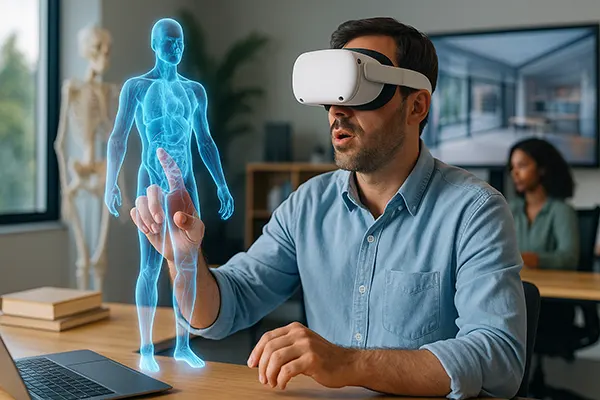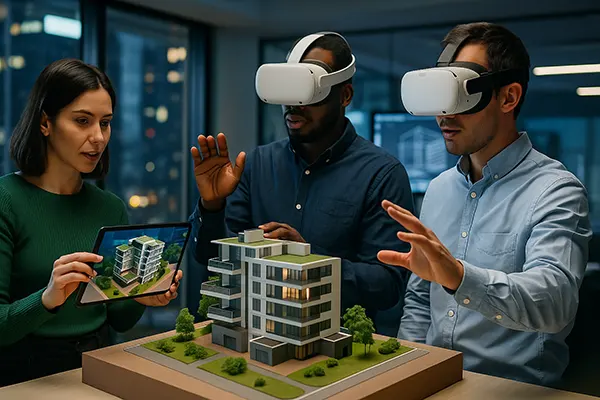Artificial Reality Platforms: How AR and VR Transform Healthcare, Education, and Design

Augmented Reality (AR) and Virtual Reality (VR) have evolved into powerful tools that significantly influence various industries. By 2025, their role in healthcare, education, and design has expanded beyond experimental projects, becoming part of everyday professional practice. These technologies improve precision, accessibility, and creativity, making them integral to both professional and consumer environments.
AR and VR in Modern Healthcare
Healthcare is one of the most promising areas for the application of AR and VR. Surgeons can now use AR glasses to visualise patient anatomy in real time during complex operations. This enhances accuracy, reduces risks, and allows doctors to prepare more effectively for procedures. The use of VR in rehabilitation also offers new opportunities, helping patients regain motor skills through immersive training programmes.
Medical training has benefited enormously from these technologies. VR simulations replicate real-life emergencies, enabling future doctors to practice responses without endangering patients. This approach ensures that medical students and professionals gain practical experience in a safe and controlled environment. The use of immersive learning tools has also contributed to reducing training costs and improving retention rates.
Telemedicine is another area where AR and VR make a difference. Remote consultations can integrate 3D models, allowing patients and doctors to better understand diagnoses and treatment options. In 2025, such innovations are particularly relevant for rural and remote regions, where access to quality medical services is limited.
Challenges and Future Potential in Healthcare
Despite significant achievements, integrating AR and VR in healthcare faces challenges. High equipment costs and the need for specialised training can slow down adoption. Additionally, data privacy and regulatory frameworks remain pressing issues that must be addressed before wider implementation.
Nevertheless, technological progress is steadily lowering barriers. Lightweight, affordable devices and cloud-based medical platforms are making AR and VR solutions more accessible. Hospitals in Europe and Asia are already piloting programmes that integrate AR into everyday diagnostic and surgical routines, setting the stage for broader adoption.
Looking forward, AR and VR are likely to become essential tools not only for advanced surgery but also for mental health therapies, personalised patient care, and preventive medicine. By blending virtual simulations with real-world diagnostics, healthcare could become more patient-centred and efficient.
AR and VR in Education
Education is undergoing a radical transformation thanks to AR and VR. Immersive lessons allow students to explore historical events, conduct virtual laboratory experiments, or practise foreign languages in simulated environments. These methods go far beyond traditional textbooks, stimulating curiosity and making learning more interactive.
By 2025, educational institutions worldwide are adopting VR classrooms and AR applications. For example, engineering students use VR to design and test prototypes in 3D environments before creating physical models. Similarly, biology students explore human anatomy with AR overlays, enabling them to better visualise complex structures.
Another key aspect is inclusivity. AR and VR are helping break down barriers for students with disabilities. Virtual classrooms can adapt to individual needs, while tactile feedback technologies provide opportunities for students with limited mobility to participate fully in learning activities.
Barriers and Innovations in Education
Although the potential is enormous, implementing AR and VR in education is not without difficulties. Schools often face budget constraints, and the technical infrastructure required for VR can be demanding. Teacher training is another crucial element; without proper preparation, the impact of these tools may be limited.
Innovations in cloud-based solutions and mobile VR applications are helping overcome some of these challenges. More affordable hardware, combined with open educational resources, is making immersive education accessible to a wider audience. Governments and private organisations are also investing in pilot projects that demonstrate the long-term value of these technologies.
In the near future, AR and VR could become standard educational tools, much like interactive whiteboards and online learning platforms. This shift will ensure that students around the world benefit from engaging, practical, and effective education methods.

AR and VR in Design and Creative Industries
Design is another sector where AR and VR have made a revolutionary impact. Architects and interior designers use VR to present clients with fully immersive walkthroughs of future buildings. This not only speeds up decision-making but also helps identify potential issues before construction begins. AR tools allow professionals to overlay design elements on real-world environments, enhancing collaboration and creativity.
In fashion and product design, AR and VR are equally transformative. Designers can test prototypes virtually, reducing material waste and speeding up the production process. Retailers use AR to create interactive shopping experiences, allowing customers to visualise products in their homes before purchase.
Moreover, the film and gaming industries are pushing the boundaries of creativity through immersive storytelling. Directors and game developers use VR environments to create content that engages audiences in new and dynamic ways. These innovations highlight how AR and VR have moved from supporting roles to becoming central creative tools.
Practical Challenges and Emerging Trends in Design
As in healthcare and education, the design industry faces its own set of challenges with AR and VR adoption. High initial costs for software and hardware, alongside the need for skilled specialists, can hinder broader usage. Smaller design studios, in particular, may struggle to integrate these technologies into their workflows.
Nevertheless, the trend towards more accessible tools is growing. Subscription-based VR design software and AR applications for smartphones are lowering entry barriers, enabling creative professionals of all levels to experiment with immersive design. Cloud rendering technologies further enhance the efficiency of virtual prototyping.
Looking ahead, AR and VR are expected to integrate more closely with artificial intelligence, providing designers with predictive insights and automated creative solutions. This synergy will redefine the future of design, ensuring that creative industries remain dynamic, sustainable, and innovative.
